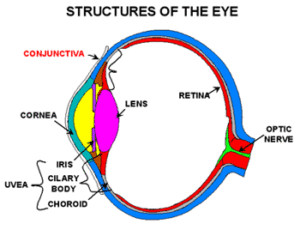Allergic conjunctivitis is the most common allergy affecting the eyes. The conjunctivae—the thin membranes covering the eyelids and the exposed surface of the eyes—is an active tissue of the immune system that responds to allergies caused by airborne particles, or allergens.

Allergic conjunctivitis can appear in two forms: seasonal and perennial. The seasonal version is much more common, and is related to exposure to specific airborne allergens, such as grass, tree and weed pollens and molds. The perennial form persists throughout the year and is usually triggered by dust mites, animal dander and feathers.
EYE ALLERGY: CAUSES AND TREATMENT
Conjunctivitis is an inflammation of the conjunctiva. This is the mucous membrane covering the white of the eyes and the inner side of the eyelids. If something irritates this clear membrane, your eyes may water, itch, hurt, or become red or swollen.
In some people, conjunctivitis is due to an allergy. In these instances, the condition is called either allergic conjunctivitis or ocular allergy. It can occur alone, or it may be associated with nasal allergy symptoms. Unlike conditions such as pink eye, allergic conjunctivitis is not contagious.
A recent study reported by Leonard Bielory, MD, FAAAAI, states that ocular allergies may be more common than nasal allergies in some areas, especially in the southern United States. And, while most people treat nasal allergy symptoms, they often ignore their itchy, red, watery eyes.
CAUSES AND TRIGGERS
If you have an allergy, your immune system identifies something as an invader or allergen. Your immune system overreacts by producing antibodies called Immunoglobulin E (IgE). These antibodies travel to cells that release chemicals, causing an allergic reaction. This reaction usually causes symptoms in the nose, lungs, throat, sinuses, intestinal tract or the eyes.
The most common allergen is pollen, which is seasonal. People with seasonal allergic conjunctivitis, or rhinoconjuntivitis will experience symptoms at certain times during the year – usually from early spring, into summer, and even into autumn (fall). Those with perennial allergic conjunctivitis are susceptible at any time of year. These irritations may be triggered by perfumes, cosmetics, skin medicines, or environmental allergens such as air pollution or second-hand smoke.
SYMPTOMS
Most people suffering from allergic conjunctivitis have problems in both eyes. Symptoms may appear quickly, soon after the eyes have come into contact with the allergen. The most common symptom occurs when the eyes become irritated, the capillaries (small blood vessels) widen and the eyes become pink or red. Some people experience pain in one or both eyes. Other symptoms include swollen eyelids, a burning sensation, sore or tender eyes.
TREATMENT
According to Dr. Bielory, about 50% of conjunctivitis cases seen by primary care physicians are actually allergic in nature. There are many different treatment options, depending upon the severity of the symptoms.
As with any allergy, the first approach for successful management of seasonal or perennial forms of eye allergy should be prevention or avoidance of the allergens that trigger your symptoms. The AAAAI Outdoor Allergens brochure offers tips on avoiding triggers.
However, avoidance of airborne allergens isn’t always possible. That is when medications may be helpful.
Over-the-counter (OTC) eye drops and oral medications are commonly used for short-term relief of some eye allergy symptoms. However, they may not relieve all symptoms, and prolonged use of some OTC eye drops may actually make your symptoms worse.
Prescription eye drops and oral medications can also treat eye allergies. Prescription eye drops provide both short- and long-term targeted relief of eye allergy symptoms, and they can be used to manage eye allergy symptoms in conjunction with an oral antihistamine that might be taken to manage nasal allergy symptoms.
Any medication placed in the eye should be kept in the refrigerator.


